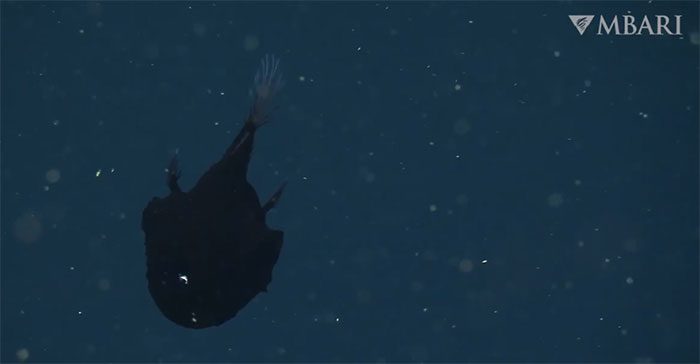Scientists have captured footage of a super black anglerfish that absorbs at least 99.5% of light in the deep sea off the coast of California.
The super black anglerfish swimming in the deep waters off the coast of California, USA. (Video: MBARI)
A team of scientists from the Monterey Bay Aquarium Research Institute (MBARI) discovered an unidentified fish belonging to the genus Oneirodes, order Lophiiformes (anglerfish), as reported by Live Science on November 15. They recorded the creature at a depth of 781 meters below the surface using a remotely operated vehicle (ROV) in the Monterey Canyon, a massive underwater canyon that stretches over 470 km off the coast of California, USA.
The research team stumbled upon this fish, which is about the size of a soccer ball, while collecting small, spiny organisms known as phaeodarians that drift in the water columns and feed on organic debris (marine snow). According to a statement from MBARI, this is the first recorded sighting of the Oneirodes fish in the Monterey Canyon since 2016.
In the video, marine snow floats around the fish, but viewers can barely make out any details of its body apart from its outline. This is because the fish’s skin is so dark that it absorbs a significant amount of light, acting like an invisibility cloak, according to Bruce Robinson, a senior scientist at MBARI.

The skin of this fish contains a large number of melanosomes – cells that hold melanin pigments.
This species is part of the “super black” deep-sea creatures, capable of absorbing at least 99.5% of incoming light. According to a study published in the journal Current Biology in 2020, there are 15 other marine species that can absorb such a high amount of light. The research reveals that their skin contains a large number of melanosomes – cells that contain the pigment melanin, which also gives color to human skin. The shape and structure of these cells allow them to absorb most wavelengths of light that strike the skin.
“The super black skin causes any light that hits it, including bright light from the bait-like lure of the fish, to be completely absorbed. There is nothing to reflect that would reveal its position,” explains Karen Osborn, a co-author of the study and a zoologist at the Smithsonian National Museum of Natural History and MBARI. This allows the Oneirodes fish to conceal itself while lying in wait and using its bioluminescent lure like a fishing rod to attract prey.
This remarkable camouflage also helps them evade predators. When the MBARI team discovered the Oneirodes fish, it was using its lure. However, the creature quickly “turned off its light” upon realizing it was being observed. The scientists identified it as female based on its size. Female Oneirodes can grow up to 37 cm long, while males only reach about 1.3 cm.





















































